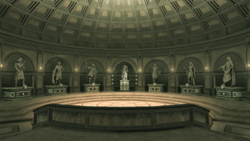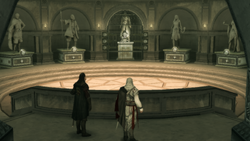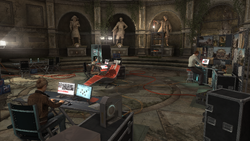This is the sanctuary. It was built by my great-grandfather to honor the memory of the Assassin Order and protect its secrets.Mario Auditore to his nephew Ezio, 1478.

The Sanctuary was a secret chamber located beneath the Villa Auditore in Monteriggioni, used by the Assassin Order during the Renaissance and modern times.
The Sanctuary was accessed primarily through an entrance hidden behind a bookshelf in Mario Auditore's study in the Villa.
Statues
The Sanctuary's most notable feature was its statues of seven legendary Assassins, who had "guarded the freedom of humanity when it was most threatened."[1]
Six of these statues each had corresponding seals at their base, which had to be collected and returned in order to unlock the gate in front of the seventh statue of Altaïr Ibn-La'Ahad. This seventh statue also held the unbreakable armor set fashioned by Altaïr using the knowledge he had gained from an Apple of Eden.[1]
These statues represented:

Atop this pedestal stands a statue of Qulan Gal, the male Mongolian assassin. He used a bow and arrow to shoot Genghis Khan's horse.

Atop this pedestal stands a statue of Wei Yu, the male Chinese Assassin. He used a spear to kill the first Chinese Emperor, Qin Shi Huang.

Atop this pedestal stands a statue of Leonius, the male Roman assassin. He stabbed Caligula with a dagger.

Atop this pedestal stands a statue of Darius, the male Persian assassin. He used his hidden blade to kill Xerxes.

Atop this pedestal stands a statue of Amunet, the female Egyptian assassin. She killed Cleopatra with a snake.

Atop this pedestal stands a statue of Iltani, the female Babylonian assassin. She poisoned Alexander the Great.

History
Early history
The Sanctuary was constructed at some point during the 14th century by Domenico Auditore, an Italian Assassin and the founder of the House of Auditore. It served as a tribute to some of the greatest Assassins in history and was also used to store the Armor of Altaïr, locked behind a gate which could only be unlocked using the seals from the six Assassin Tombs hidden across Italy.[1]

At some point in his youth, Mario Auditore, Domenico's great-grandson, visited the Sanctuary and learned about the tombs. Though he sought them out, he was unable to find any and ultimately gave up on his search.[1]
In 1478, Mario revealed the Sanctuary to his nephew Ezio as the latter was becoming devoted to the Assassin cause, and encouraged him to seek out the tombs.[1] Between 1478 and 1497,[2] Ezio found and explored all six tombs, retrieving their seals, which allowed him to obtain the Armor of Altaïr from the Sanctuary.[3]
Siege of Monteriggioni

During the Fall of Monteriggioni on 2 January 1500, the Sanctuary was used as a temporary haven for survivors fleeing the attack, in which a passageway behind the statue of Altaïr served as an escape route for Ezio, his family, and several hundred of the townspeople.[4]
This hidden door led them into the tunnels underneath Monteriggioni, which were also connected to the Auditore Family Crypt, and ultimately allowed Ezio and the others to escape to safety.[4]
In 1509, Seraphina, a member of the Cult of Hermes who had infiltrated Monteriggioni, used the Sanctuary's secret passageway to flee the town after stealing several precious Auditore relics and making a failed attempt on Ezio's life.[5] The Assassin pursued her and her accomplices into the Sanctuary and through the underground tunnels, but Seraphina ultimately managed to escape.[6]
Modern times
Whoa, they built this place to last. No signs of structural damage, and no cell signal either. This place is perfect.Rebecca Crane, upon entering the Sanctuary in 2012.

Centuries later, in September 2012, a team of Assassins sought out the Sanctuary, as their first hideout had been found and raided by Abstergo Industries.[7]
Desmond Miles and Lucy Stillman traced back the escape route used by the townspeople after the siege in 1500, in order to unlock the bookcase entrance, and allow Rebecca Crane and Shaun Hastings to gain access to the chamber.[7]
The modern Assassins then used it as a refuge, since its underground structure was ideal in protecting them from Abstergo's cell phone surveillance. However, as the Sanctuary had no electricity, Desmond was tasked with navigating around modern-day Monteriggioni and rerouting power to the safehouse.[7]
Trivia
- The circular grate in the courtyard at the back of the Auditore Family Villa was actually the top of the Sanctuary, which allowed light in. The Sanctuary could not be viewed from the outside, however.
- In Assassin's Creed: Brotherhood, the grate at the top of the Sanctuary appeared broken from the inside, even though when viewed from the outside, it appeared undamaged.
- In Assassin's Creed II, all of the statues could be examined to gain information about the Assassin, with the exception being Altaïr's statue. In Brotherhood, only the statue of Altaïr could be interacted with, resulting in a short cutscene that involved Desmond using a stereotypical Italian accent, and Rebecca scolding his "racism." This process could have been repeated until Sequence 6, though without Rebecca's reply.
- Although all of the Assassin statues, other than Altaïr's, had the small skull mechanisms that opened the entrances of the Assassin Tombs, they could not be interacted with.
- In Brotherhood, the skull mechanisms have been removed from the statues during the siege of Monteriggioni, but reappear in modern Monteriggioni.
- Desmond could interact with his teammates or certain items in the Sanctuary during each memory sequence, triggering a variety of conversations.
- Although Mario refers to the individuals depicted in the Sanctuary's statues as members of the Assassin Order, only Altaïr and Qulan Gal were proper Assassins. All the others lived centuries before Hassan-i Sabbāh's reformation of the Hidden Ones into the Assassins, with Darius, Iltani and Wei Yu preceeding the establishment of the Hidden Ones itself.
Gallery
Appearances
References
- ↑ 1.0 1.1 1.2 1.3 1.4 Assassin's Creed II – Floating conversations: Unlocking Monteriggioni's Secrets
- ↑ Assassin's Creed: Brotherhood – Love's Labour's Lost
- ↑ Assassin's Creed II
- ↑ 4.0 4.1 Assassin's Creed: Brotherhood – Emergency Exit
- ↑ Assassin's Creed: Nexus VR – Return to Monteriggioni
- ↑ Assassin's Creed: Nexus VR – Monteriggioni Tunnels
- ↑ 7.0 7.1 7.2 Assassin's Creed: Brotherhood – Modern day
| |||||||||||||||||||||||||||||||||||||




